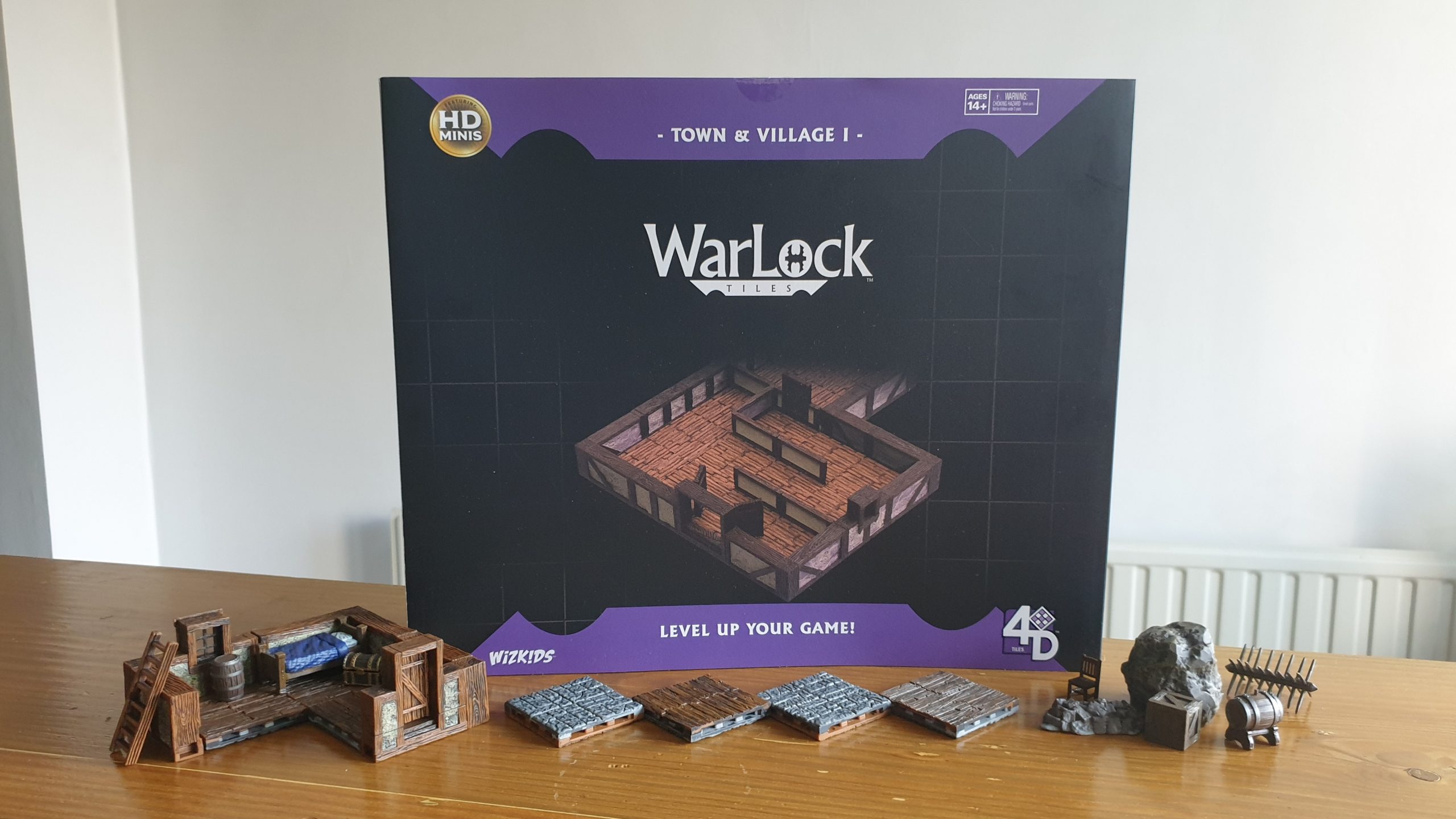WizKids has recently launched a range of products called WarLock Tiles, a modular system that enables role player gamers to “Level-Up” their tabletop experiences. Utilizing their WarLock clips, 2” by 2” tiles can be linked together, with thick outside walls and thin indoor walls to create multi-room scenarios – for the likes of Dungeons & Dragons and Pathfinder. We were able to get hands on with one of the two base sets and a few of the smaller additional sets, to put it through its paces. However, is this the upgrade for everyone and what sets should those interested look to get? Let’s find out!
Editor’s Note: The miniatures and dice seen in the pictures are not included in any of the WarLock sets. Where possible the images have been labelled to detail which sets are included in the constructed buildings.
WarLock Tiles: Town & Village 1
Classed as a base set, Town & Village comes with 24 floor tiles, plenty of inside and outside walls, two types of opening doors and windows. Effectively, it is all players will need to turn their RPG experiences 3D, or “4D” as the box says – supposedly the dungeons or the dragons being the 4th D. The floor tiles clip together using WarLock clips, of which an abundance are included. There is a bit of a technique to clip the tiles togethers, with a fair bit of pressure needed, with internal walls neatly fitting between tiles and outside walls clipping to the floor tiles. Once clipped together the rooms aren’t going to come apart from being nudged by players moving miniatures. Allowing the DM (Dungeon Master) to keep the suspense, it also allows a room to be built beforehand but kept off the table until it is needed.
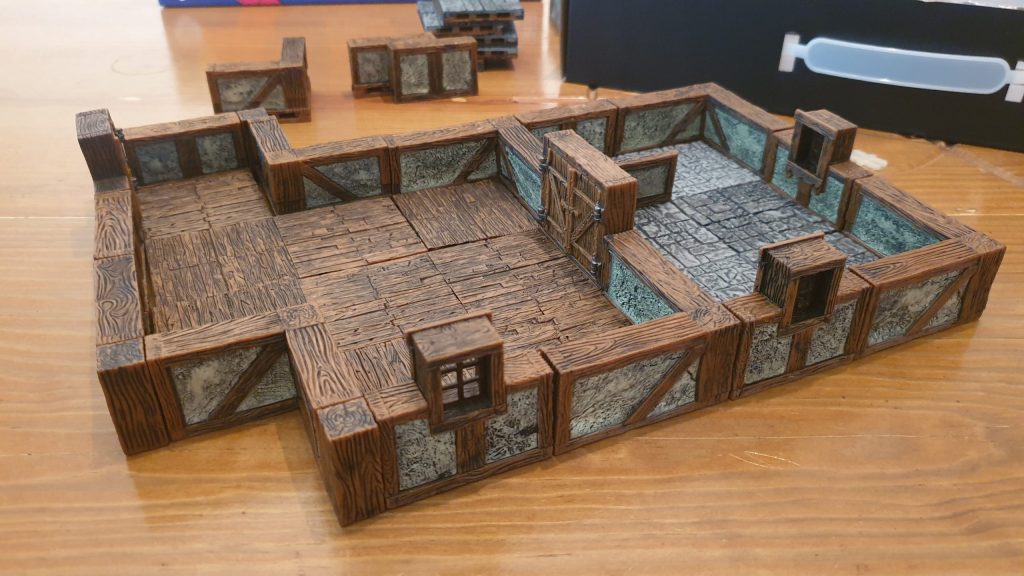
The included WarLock Tiles are all 2”x2”, or ~5cm x 5cm. This means there are plenty of ways to design unique buildings and sub rooms. If following exact sizing from D&D campaign books this may lead to a few awkward moments size wise. Currently, there isn’t an option to make rooms an odd number of spaces across: perhaps this will be possible via future releases but it certainly isn’t with just this set. Narrow corridors to bottleneck environments will therefore always be 2 spaces across – though this is where the Dungeon Dressing content can come into play, to block spaces.
Due to the way that the inner and outer corner wall pieces work, my initial concern was that they’d be a little limiting when it comes to the shapes that rooms, or full dwellings, could be – at least with just this base set. With the 5 outer corners, which sit outside of the 2” x 2” tiles, and 5 inner corner walls, which sit where tiles would be, players are already not that limited. These corner walls can be placed in different configurations with the wall pieces to craft vastly different buildings, but this is where the 8 included posts truly shine. Looking almost the same, players can add posts onto the end of wall sections to increase their length slightly, and effectively make additional corner wall pieces. So, players can let their imaginations run wild and have very oddly shaped buildings.
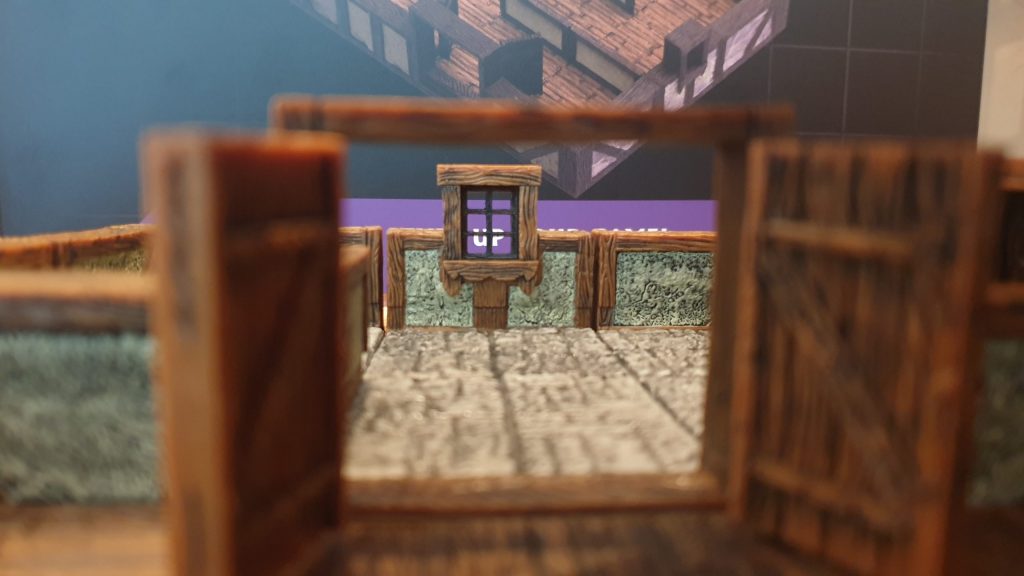
Having double sided tiles is ideal for making it super simple for DMs to quickly make two buildings look unique – even if the shape of rooms remains the same. The wooden boards have a real texture to them, with the colour almost warming. Conversely, stone flooring makes rooms instantly feel more solid and cold, from the colouring used. Despite visually looking like a complete floor, the care that’s gone in the design is clear – as it is still easy to see each 1”x1” space. Therefore, the ability to see distances at a glance hasn’t been lost – so players cannot blame the tiles for misjudging and getting too close to an enemy!
The walls of the Town & Village set are all referred to as plaster. Putting aside the corner walls, for the outside there are normal walls and some with windows and then there are three styles for the thin inner walls. These help to break up walls that otherwise could look either too perfect or oddly samey. It is a bit of a shame that this same attention to detail wasn’t shown to the floor tiles, as an odd cracked stone or broken floor board could have just added even more detail to the already stunning creations.
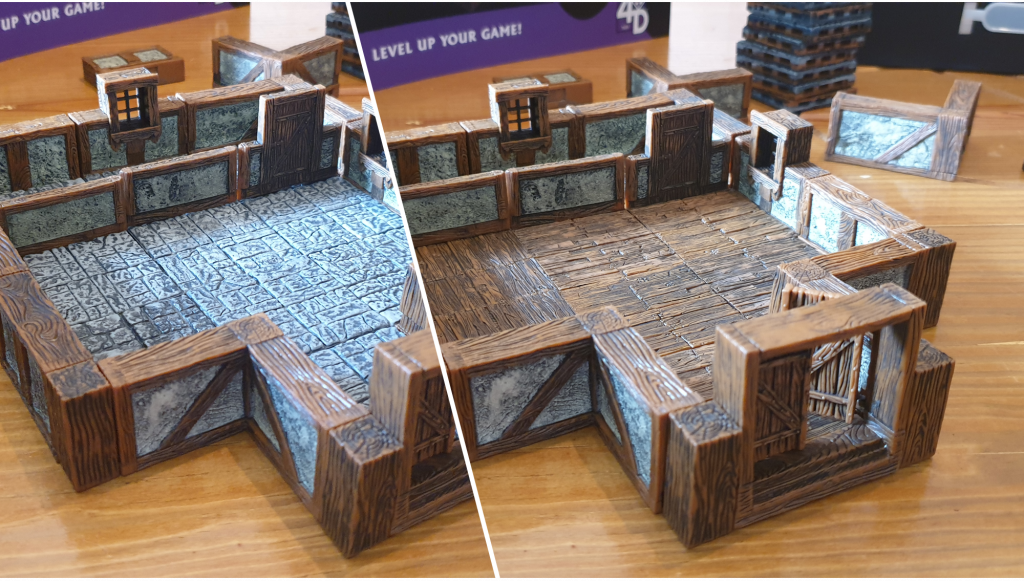
As a set it is called Town & Village though perhaps Homes & Taverns would be a more appropriate name. Large buildings with multiple rooms can be created with the set on its own. Designs might be brought even more to life with other content but there is plenty of wow factor to the base set. It is however hard to create more than one building, with extremely limited possibilities for outside style terrain – being limited to the stone flooring side of the tiles. Also, the individual buildings would have to be on the small side, which isn’t necessarily a problem.
Part of the fun of RPG games is moving into an unknown area. As a DM you can have players walking up to a building and then drop it onto the table when they barge down the door. What you cannot as successfully pull off, without owning a number of these base sets, is having a tiny section of a street in front of players – almost like a small map to explore. The quality of the content in the box makes you want more, to expand the possibilities past just one base game box. In turn this makes what is already a not cheap purchase a potential future danger to your wallet.
Expansion Box 1
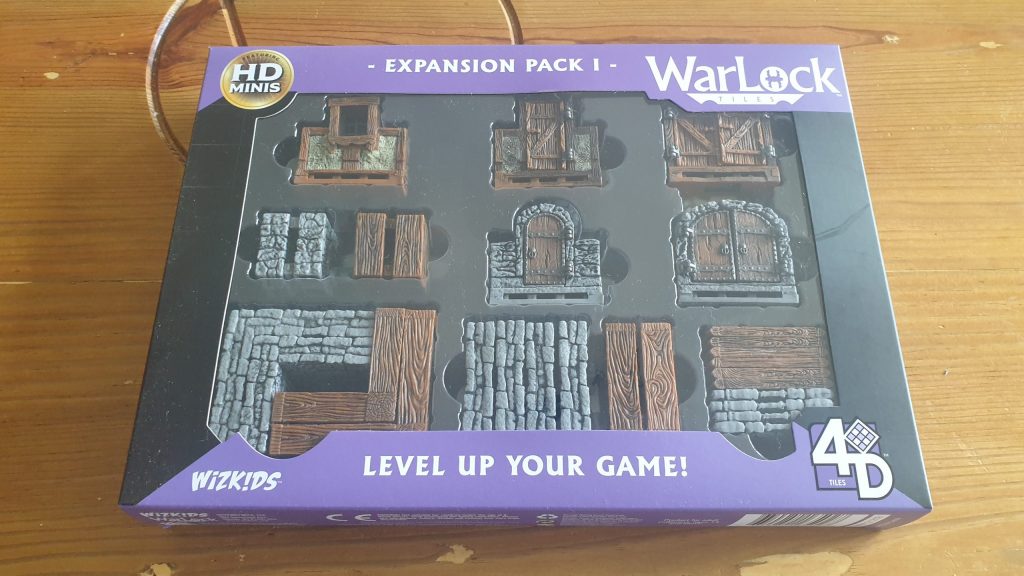
Having the expansion box gives gamers with one of the core boxes, Town & Village or Dungeon Tiles, the opportunity to dabble with a different wall type. There aren’t enough included to construct a huge building though. Still, there is enough to craft a zone with stone walls adjacent to a tavern with the Town & Village set, or a small building with a secret passageway into a dungeon with the Dungeon Tiles set. Coming with only doors, walls and corner walls, it is important to note that this does not come with additional floor tiles. By not including any additional floor tiles it limits the effectiveness of this set as an expansion, as players won’t actually be able to expand the size of their creations. While I cannot definitely say it is the case for the Dungeon Tiles base set, the Town & Village base set includes enough walls and corner walls (especially with the posts) for almost all building designs.
Allowing for a touch more variety is therefore the reason you may want this expansion box. Longer corridors and more intricate interiors are slightly more achieveable. The issue with the set comes down to being split 50:50 between the two wall types, so there is a sense of only being able to properly use half of the content, if owning only one of the base sets. If you had both it would therefore be much better value, as you’d get more use out of the content. As a result this is probably one of the sets that I would suggest skipping unless you already have the rest.
Dungeon Dressings
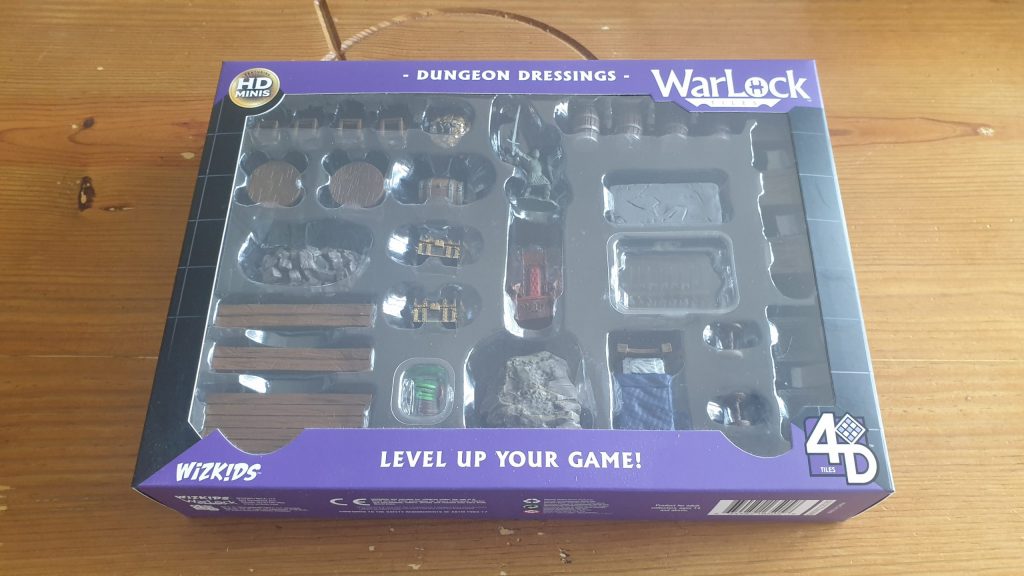
After one of the base sets of the WarLock Tiles, the Dungeon Dressings set should be the first thing many look towards getting next. It doesn’t expand the size of a dungeon or tavern, nor does it allow for a higher amount of variety when it comes to the shapes of buildings – like the expansion box. Instead of enlarging, it helps players add the details to the corners of rooms or corridors. These details take what is otherwise an extremely nice but empty shell of a room and make it closer to a living world.
All of a sudden players around the table can spend even less energy conjuring up the interior of a bard’s house or a local drinking well in their imagination. The tiles and walls do a huge amount of this. Yet it is the barrels, benches and more from this pack that elevate the locations into truly believable ones. Adding even a little detail to each room, or helping to add obstacles for the players to work around, steps the WarLock tiles up from simple rooms to locations that are instantly unique, not just in shape but in feel.
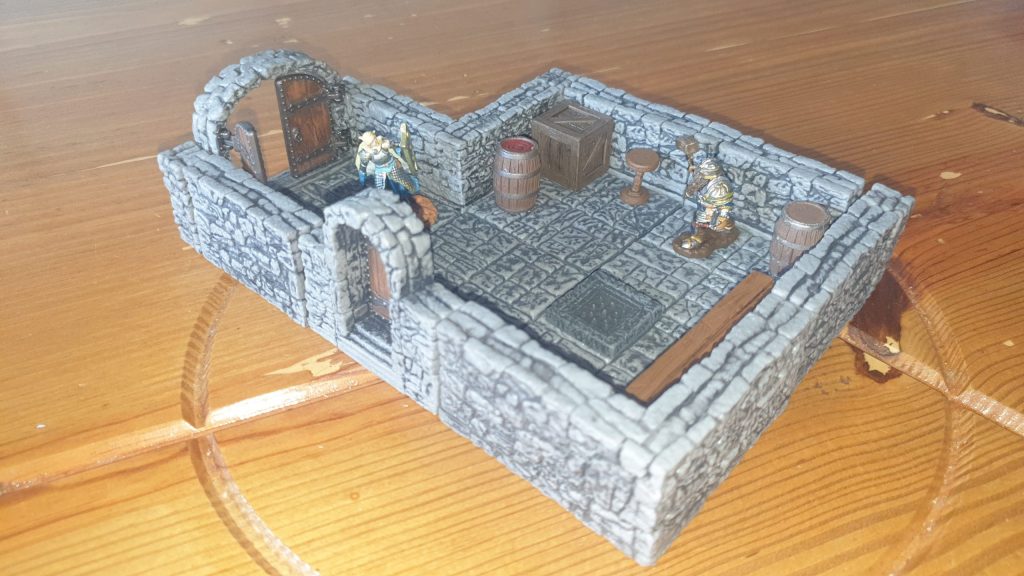
The selection of items allows a variety of rooms to be generated, including the likes of a busy tavern or a guest house. Using items such as the beds, chests and tables a sleeping room area can be created, while replacing them with crates and barrels forms a store room. The Dungeon Dressings set would work with the Dungeon Tile set or the Town & Village set. It comes with pieces that fit both sets, with generic barrels and crates. There are however elements that only fit one or the other set. Spike traps and the cheval de frise only really fit a dungeon setting. Conversely, the perfect wooden chairs or the comfy looking bed would be out of place in a dungeon.
While it is a great set for creating lifelike and lived in locations, two separate and more developed sets for the dungeon and town base sets could have been more useful for those not picking up both core sets. The only real quality issue of this set is an odd choice on the barrel front. The set comes with barrels with one open end, and end caps of three colours to pop in. Popping these coloured caps back out however is no easy task, and not every location needs a barrel full of a questionable green liquid. Thankfully, there is however always the option to use these barrels upside down, utilizing the non-open end.
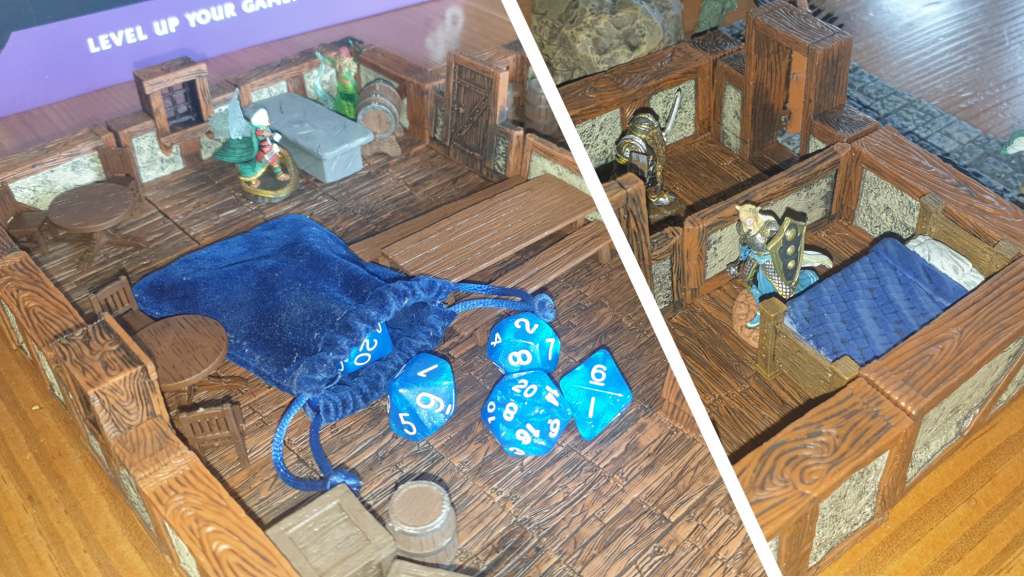
Stairs & Ladders
Coming with wooden and stone stairs, stone spiral staircases, wooden ladders and even elevated sections for walkways, the Stairs & Ladders set gives the WarLock Tiles a little verticality and the ability to feature multi-floored dwellings and dungeons. By using the elevated sections along the side of a room, with a staircase, it transforms the flat building designs. More importantly, using a staircase to take players up to a room on a different level makes the buildings that bit more believable – not every house or building is a bungalow in real life.
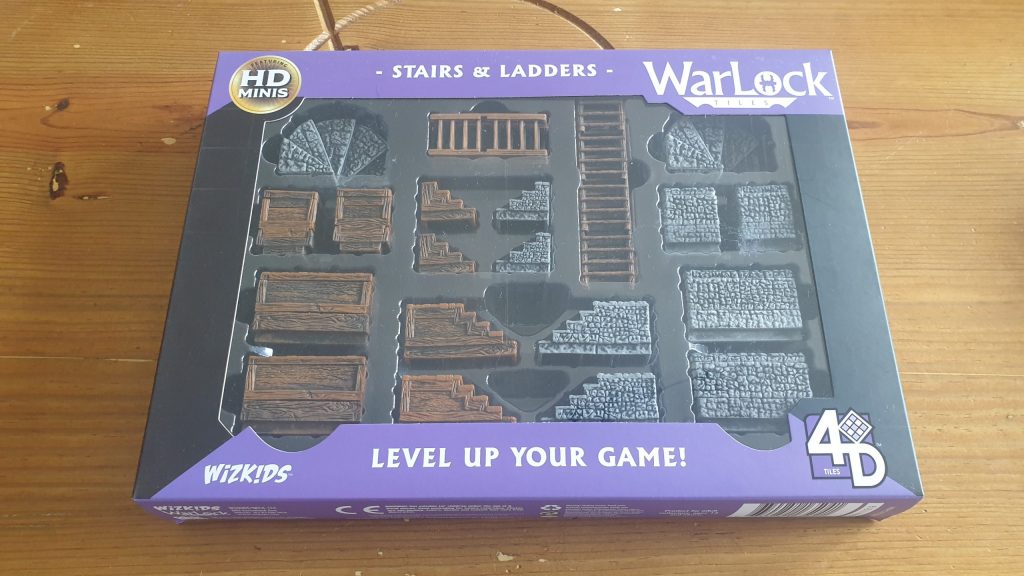
This can be achieved by having a staircase off to one side and a separate room set up nearby for the second floor. Instead, with some creativity, using the elevated walkways (which split into a couple of different heights) players can set up the second room adjacent to the first room but physically higher. This gives the buildings actual height, something which brings the environment literally more off the table than paper maps ever could. The only usability issue encountered has been that the ladders are a little prone to slipping on the tiles. Easily solved with some blu-tac this becomes obvious when rooms get nudged. Stairs and most of the Dungeon Dressing furniture items move with the tiles, whilst the propped up ladders slide a little along the floor.
Unlike the Dungeon Dressing set not every building or location is going to need a staircase, nor a ladder to a second floor. At times there will be a number of parts of this set that stay in the box, until the adventuring party visits a location which requires them. Still, the ladders can be used as additional props for a location. Also, there is always the option to simply use the stairs and elevated walkway sections to give some height difference – more to give some texture to the location than routes to other floors.
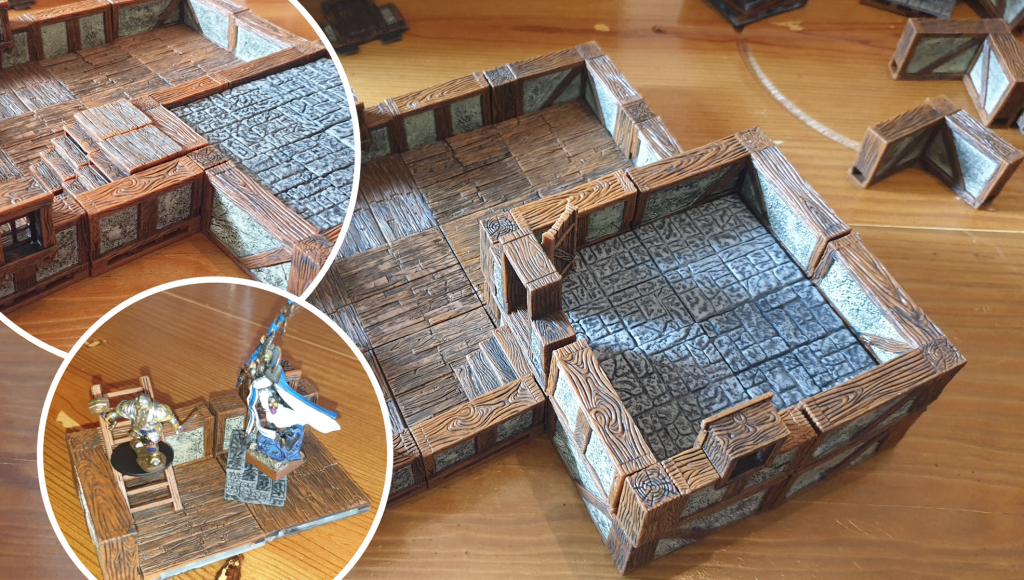
The stairs and the ladders do have one step or run that looks different from the rest. This is because they have been designed to allow a miniature to stand on that space. This is extremely useful during combat when knowing the exact ranges matters to players and the DM – even if it looks a tad odd to see the miniature slightly floating. The gaps are perfectly sized for the slim disk bases that the new WizKids pre-painted premium miniatures come on, and have even worked with an older square Warhammer miniature base – though they probably wouldn’t work with all custom bases.
Overview of WarLock Tiles
There is no denying that the WarLock tiles have a wow factor. Anyone that has played the likes of D&D or Pathfinder can see how these almost luxury sets could elevate their role playing experiences. The sheer amount of potential in just the Town & Village base set is impressive, with so many building and room designs possible. While the extra content is more situational in usage, they do take what already looks stunning to the next level – making rooms fuller and more lifelike.
From a functionality perspective the tiles and walls lock together very well. They need slightly more than minimal force to push together, though they pull apart relatively easily for packing away. There is some minor movement there when lifting a pre-built room or dungeon onto the table. Still, as soon as it is flat on the table if a player nudges any of the tiles or walls, even the internal ones, the whole room will move – so parts of a dungeon won’t randomly be knocked and nudged into misalignment.
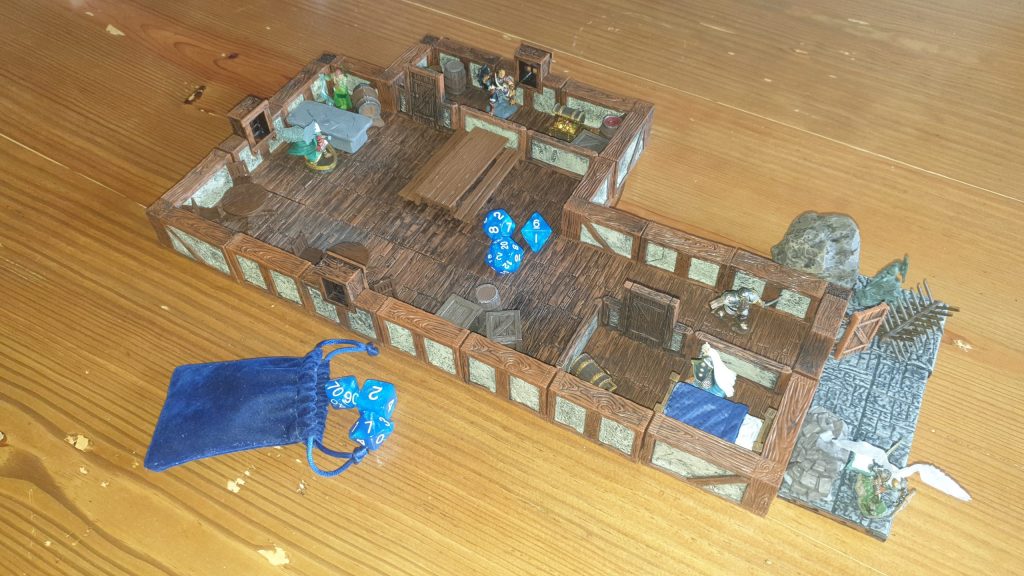
There are limitations though and gamers should be aware of this before purchasing any WarLock Tiles content. The biggest limitation is the number of floor tiles in a base set, which as you can see above allows for medium-large buildings. This, more so than the number of walls or corners, is what will limit the creations you’ll be able to make, and maps you’ll be able to replicate. Without odd or peculiar shaped floor and wall pieces there is also the 2” by 2” uniformity players will have to work with. For example, RPG maps of town buildings can often feature curved walls which just aren’t possible. Courtyard areas are also out of reach without a couple of base sets, and even then the content only really looks at internals of buildings or dungeons.
Overall, it is still the variety of buildings that just one base set can create which will allow it to grace the table any time a party goes to a location. For the minor limitations it will constantly make players’ jaws drop, so it is hard not to get caught up in amazement at the product. For many this may be one indulgence that is too far out of their budget. One base set is just the start of the journey and the Dungeon Dressings set is needed alongside it to make the locations feel tremendously different. If it is affordable for you then you could soon be playing on a solid, high-quality, imagination driving, stunning tile set. Alas, for others it may fall into the “one day I’d love to own that” category.
(Editor’s Note: The WarLock Tiles sets were provided to us by Asmodee for the review. They are currently available from local board game stores, some of which are reopening! Find your local store here.)

